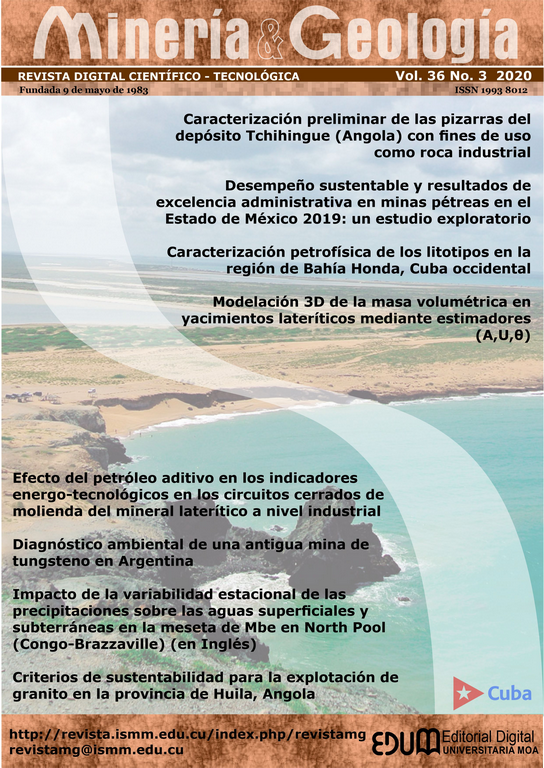Effect of additive oil on energy-technological indicators in closed-grinding circuits for laterite ore on industrial level
Keywords:
additive oil, nickel production, ball mill, lateritic mineral, energy indicators.Abstract
The decision of adding oil to the feed of lateritic ore mills at Ernesto Che Guevara nickel factory is related to the need of reducing production costs. The purpose of this study is to evaluate the effect of this variable on the energy-technological indicators of milling. Two series of tests were carried out: the first, to obtain the regularities of the influence of the additive oil in the particle size classes of +0.149 mm and -0.074 mm in the product of the milling. The second series evaluated the influence of additive oil on the mill's production and its energy consumption. It could be established that the addition of crude oil brings about an increase of the class + 0.149 mm in the milling product.-0.074 mm class is increased with a turning point in the additive oil consumption of 4%. Percentage increasing of crude oil addition steps up the amount of material adhering to the balls and mill walls. Industrial tests show that the addition of crude oil decreases mill productivity by 12% and increases energy consumption by 6.26 kWh / t.Downloads
References
Bond, F. C. and Agthe, F. T. 1960: Deleterious coatings of the media in dry ball milling. Mining Technol., 4.
Coello-Velázquez, A. L. 1993a. Informe sobre el estudio del efecto del petróleo aditivo en la molienda de las lateritas. Planta de Molienda. Empresa Cmdte Ernesto Che Guevara.
Coello-Velázquez, A. L. 1993b: Consideraciones sobre la molienda seca de minerales lateríticos. Minería y Geología, XIII(2): 37-42.
Coello-Velázquez, A. L. 1993c: Sovershenstvovanie tecnologii izmilchenii lateritobij pud na zabode Punta Gorda. Diss. Uch. step. Kand. Doct. Tejn. Nauk. IMS. Saint Petersburg.
Coello-Velázquez, A. L. 2001: Molienda de minerales multicomponentes: Modelo integro-diferencial para la valoración de la energía. Minería y Geología, XVII(3-4): 49-53.
Coello-Velázquez, A. L.; Menéndez-Aguado, J. M. y Laborde-Brown, R. 2008: Grindability of lateritic nickel ore in Cuba. Powder Technology, 182: 113-115.
Cuhadaroglu, A. D.; Kizgut, S.; Yilmaz, S. y Zorer, Y. 2013: Characterization of the Grinding Behavior of Binary Mixtures of Clinker and Colemanite. Particulate Science and Technology, 31: 596–602.
García, A. y Llorente, L. 1999: Informe sobre las pruebas del petróleo aditivo en el molino 2 de la planta de molienda y secaderos de la Empresa Cmdte Ernesto Che Guevara.
Grzymek, J.; Gustaw, K. and Ostap, K. 1965: Der Ein-fluB oberilSchenwirksamer Zusatzstoffe auf den Mahlvorjiangbeim Mahlen von Portland-Zementklinkcr. Cemcnt-Wapno-Gips, 52: 1-7.
Kennedy, H. L. 1936: Portland cement-effects of catalysis and dispersion. Ind. Eng. Chem., 28: 963-969.
Laborde, R.; Coello-Velázquez, A. L. y Angulo, O. 2003: Racionalización del consumo de energía en la molienda de los minerales lateríticos. La Habana: SIE.
Llorente, L. 2003: Proyección para el incremento de la productividad hasta 50 mil t de níquel + cobalto en la instalación de molienda de la fábrica Ernesto Che Guevara. Alfredo Lázaro Coello Velázquez y Juan María Menéndez Aguado (Tutores). Tesis de maestría. Instituto Superior Minero Metalúrgico de Moa.
Magoteaux, 1998: Informe técnico sobre el trabajo de la instalación de molienda de la Empresa Cmte ECG. Planta de Secadero y Molienda. Empresa Cmdte Ernesto Che Guevara.
Montante, A. 1999: Uso de aditivos en el clinker del cemento Portland. Antonio Fernández (Tutor). Tesis de maestría. Universidad de Nuevo-León. México.
Novoa, L. G. 2011: Aprovechamiento del coque de petróleo para la producción de coque siderúrgico. Yamín Agámez Pertuz (Tutor). Tesis de maestría. Universidad Nacional de Colombia. Bogotá, Colombia. 116 p.
Revuelta, L.; Fernández, L.; Forrego, F. and De Luxan, M. P. 2003: Influence of the clinker and cement aids on the intrinsic characteristics of cements and the behavior of mosters. Materiales de la Construcción, 53: 271-272.
Schneider, H. 1969: Sobre el empleo de aditivos de molienda en la molturación de cemento. Zemenf'Kalk-Oips, 5: 193-201.
Wills, B. A. and Finch, J. A. 2016: Particle size analysis. Wills’ Miner. Process Technol, 8: 91-107.
Published
How to Cite
Issue
Section
Copyright (c) 2020 Alfredo Coello Velazquez

This work is licensed under a Creative Commons Attribution-NonCommercial 4.0 International License.
- Authors retain copyright and guaranteeing the right magazine to be the first publication of the work as licensed under a Creative Commons Attribution-NonCommercial that allows others to share the work with an acknowledgment of the work's authorship and initial publication in this journal.
- Authors may establish separate supplemental agreements for the exclusive distribution version of the work published in the journal (eg, place it in an institutional repository or publish it in a book), with an acknowledgment of its initial publication in this journal.
- Authors are allowed and recommended to disseminate their work through the Internet (e.g., in institutional telematic archives or on their websites) before and during the submission process, which can produce interesting exchanges and increase citations of the published work. (See The effect of open access)










